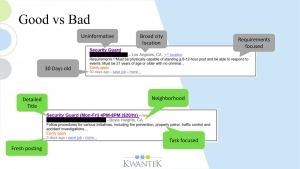HOW MANY OFFICERS TO HIRE
Armand Adkins, Security Alliance Group
Once a client realizes that there is a need for security officers in their business, home, or event, the next issue they face is how many officers they need to hire. This is one of those questions without a cut and dry answer. The number of officers varies depending on several factors, such as location, number of guests or customers, the purpose of the business or event, and if alcohol is involved. We will take a look at each of these factors before making certain people-to-guard ratio suggestions you can bear in mind the next time you have to answer the question of how many officers to hire. Having the correct ratio is essential to all involved in order to minimize security risks.
Factors to consider
Location: This is the first point to consider, for if the event, business or residential home is located in a troubled area, it would necessarily require hiring more security officers than normal.
Venue: Is it a small or large venue? How many doors or entrances does the venue have? At least one security guard per entrance is rule of thumb. Is the venue one big open space or a closed place with different rooms? The smaller the venue, less officers are needed to cover the space, while the larger the venue, the more officers will be needed.
Number of People: As we’ll see later in the suggested ratios of officers to people, the more people, the more officers, while the number of people is closely related to the venue. If you are going to have a large crowd, then the venue should be large enough to accommodate the expected crowd. The better the crowd is accommodated, the less the risk of security situations that may arise.
Alcohol: Are you having a party where alcohol will be served? Or are you running a bar or club? If alcohol is now part of the equation, more security officers will need to be hired to maintain order and balance among patrons.
Type of Event: What is the purpose of the event or area that needs to be secured? An event where expected guests are VIPs, HNIs (high net-worth individuals), or celebrities, will require more security officers.
Demographics: Factors such as gender and age should be weighed when considering the number of officers to hire. An event with mostly children in attendance would need fewer officers than an event with young male adults or a mixture of males and females.
Parking Lot: Are you providing space for visitors and guests to park their vehicles? Most businesses display a disclaimer relinquishing liability for any loss or damage to properties left in the parking lot. “Cars Parked At Owner’s Risk.” Yet, this does not mean you will not need security officers patrolling your parking lots. Remember, the presence of a security guard is a great deterrent for negative behavior. This should be factored in with the number of officers needed.
Mode of Invitation: Did you put out an open invitation on social media or online? Whether for parties or other events, more security officers need to be hired.
Type of Business: A bank will definitely need more officers than a restaurant. The higher the risk involved in a business, the higher the number of officers needed.
State of Things: The general state of security should be considered. For instance, during play-off games or other major sporting events, the general state of security is tense and on high alert in areas where people are gathering together to view games. Hosting an event during such a period will necessitate hiring more officers. In the current state of lockdown and social distancing, more officers are needed in areas like grocery stores, hospitals, and open essential businesses.
Known Threats: Has someone promised to crash a wedding or vandalize a place of business? Or threatened to steal some property? This necessitates more security officers than usual until the threat is eliminated.
Security Devices in Use: Will most areas be covered by security cameras? This can help you determine the number of officers needed.
Managing a Security Situation: In addition to the above items, it is also helpful to think through the number of officers needed if a security situation occurs that would require the intervention of officers. For example, if a party is underway and two guests get into a fight, how many security officers would you need to keep the situation under control? Remember, you still need someone watching the rest of the guests and the entrance.
While the factors to consider above have no absolute answers regarding the number of officers, they are to be considered as a whole when advising clients on proper security staffing.
Guard to Guest General Ratios
The following ratios should be considered a general guide when deciding on the numbers of security officers.
Standard practice is to have one guard stationed at each entry point.
Less than 10 guests with one entrance, 1 security guard.
Between 10 – 50 guests with two entrances, 2+ security officers.
50 – 100 guests with three entrances, 4+ security officers.
100 – 250 guests with three entrances, 8+ security officers.
250- 1000 guests with at least four entrances,30+ security officers.
The above ratios are for considerations and not a dictation of hard rules. Remember, whenever alcohol is involved means more security officers than usual, and where there are young adults and alcohol, the usual number of officers needed can be tripled.
Conclusion
After all has been said and done, it is the working knowledge and experience of the security guard company that is paramount. Such a company will provide well trained officers and be familiar with the type of event or business. And when a company is asked about the level of security to have on-site, the factors and issues raised in this article are here to help in reaching a thoughtful recommendation.
 Armand Adkins is CEO of Security Alliance Group (SAGPro.com), a provider of best-in-class support services/systems for small to mid-sized private security guard companies.With 25 years of legal, compliance and operational experience, Armand leads a dynamic company that delivers two unique services to address the training and hiring needs of security companies.
Armand Adkins is CEO of Security Alliance Group (SAGPro.com), a provider of best-in-class support services/systems for small to mid-sized private security guard companies.With 25 years of legal, compliance and operational experience, Armand leads a dynamic company that delivers two unique services to address the training and hiring needs of security companies.
GuardsLink platform gives security companies the ability to provide their employees branded online training that is both affordable and quality, and includes an integrated system to monitor and manage guard training.
SecurityHires (SecurityHires.com) is a security industry focused job board designed and built using cutting edge technology to assist in all the hiring requirements of security companies seeking qualified guards.
Those looking for an intuitive and robust training solution implemented at no cost with a revenue sharing model, or more information regarding the benefits of the industry specific job board, should contact Armand at info@sagpro.com or call (888) 360-9373.

 Jaimee K. Wellerstein is a Partner at Bradley & Gmelich LLP, and the Head of the firm’s Employment Department. Jaimee concentrates her practice in representing employers in all aspects of employment law, including defense of wage and hour class actions, PAGA claims, discrimination, retaliation, harassment, wrongful discharge, misclassification, and other employment related lawsuits. She also provides employment counseling and training in all of these areas.
Jaimee K. Wellerstein is a Partner at Bradley & Gmelich LLP, and the Head of the firm’s Employment Department. Jaimee concentrates her practice in representing employers in all aspects of employment law, including defense of wage and hour class actions, PAGA claims, discrimination, retaliation, harassment, wrongful discharge, misclassification, and other employment related lawsuits. She also provides employment counseling and training in all of these areas. Named to IFSEC’s Global Influencers list 2018 for Security Thought Leadership, Mark is a business school graduate, CPP and Member of The Security Institute (MSyI). Mark’s background is in security services, corporate security, consulting and workforce software. A graduate of Concordia University in HR Management and International Business, he progressed to several senior management roles responsible for security business units across Canada, including serving as the Senior Manager for Corporate Security at Canada’s largest telecommunications company. He launched a consulting business focused on physical security for corporate clients, and has been teaching part-time at the Université de Montréal since 2016. Currently, Mark is the Vice-President, Security and Industry, in the software scaleup TrackTik, and volunteers as SRVP Region 6, Chair of the Security Services Council, the Private Security Officer Standard Technical Committee, and the Private Security Company (PSC.1) working group.
Named to IFSEC’s Global Influencers list 2018 for Security Thought Leadership, Mark is a business school graduate, CPP and Member of The Security Institute (MSyI). Mark’s background is in security services, corporate security, consulting and workforce software. A graduate of Concordia University in HR Management and International Business, he progressed to several senior management roles responsible for security business units across Canada, including serving as the Senior Manager for Corporate Security at Canada’s largest telecommunications company. He launched a consulting business focused on physical security for corporate clients, and has been teaching part-time at the Université de Montréal since 2016. Currently, Mark is the Vice-President, Security and Industry, in the software scaleup TrackTik, and volunteers as SRVP Region 6, Chair of the Security Services Council, the Private Security Officer Standard Technical Committee, and the Private Security Company (PSC.1) working group.

